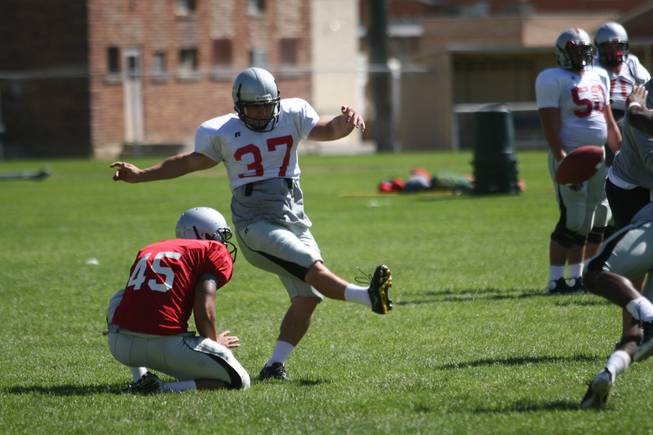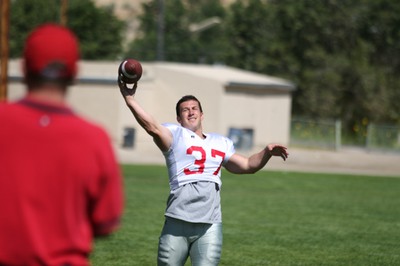
Ryan Greene/Las Vegas Sun
UNLV kicker Kyle Watson (37) boots a short field goal attempt Aug. 17 during practice at Broadbent Park in Ely.
Monday, Oct. 12, 2009 | 2:10 a.m.
Audio Clip
- UNLV senior kicker Kyle Watson, a Southern California native, on attending the historically black Texas Southern in Houston in 2005.
-
Audio Clip
- Watson on leaving the Tigers’ program after one season.
-
Audio Clip
- Watson on having any regrets.
-
Audio Clip
- Watson on the only color mattering on a football team is on its jerseys.
-
The Rebel Room
BYU POSTGAME: Rebels run ragged ... again
Ryan Greene, Rob Miech and Alex Adeyanju digest all there was to take in from UNLV's 59-21 loss to BYU on Saturday night at Sam Boyd Stadium.
Next game
- Opponent: Utah
- Date: Oct. 17, 7 p.m.
- Where: Sam Boyd Stadium
- TV: The Mtn. (Cox ch. 334)
- Radio: ESPN Radio 1100 AM
- The Line: Utah by 17
UNLV senior kicker Kyle Watson doesn't think of himself as a pioneer or a trailblazer by being among the first white players at historically black Texas Southern.
He just wanted to play football.
In the fall of 2005, he got more out of kicking for the Tigers and attending classes at the Houston institution than he could have imagined when he left Southern California.
Like Marcus Jacoby, the first white starting quarterback in the history of Southern University in Baton Rouge, La., in 1996, Watson received a daily education.
In a "History of Civilization" class at Southern, Jacoby learned about blacks who made significant contributions and played important roles that he had never heard of before.
"I was expanding my knowledge," Jacoby told the New York Times. "Before this, I had learned history only from the white perspective."
In a speech communications class at Texas Southern, Dr. Martin Luther King and Malcolm X were some of the subjects Watson and his peers studied.
"I definitely had many moments like that," Watson said of Jacoby's experiences. "At an HBCU (historically black college or university), all their teachings were on African-Americans, their contributions and what they made of themselves.
"It's pretty much all you were taught. It definitely opened your eyes to things I had never been taught. It was different and interesting to learn, putting yourself in others' shoes and seeing how others see things."
An offer he couldn't refuse
At Rancho Cucamonga (Calif.) High, Watson received scant collegiate interest. There were some form letters, but no college coach from the elite FBS (former I-A) saw him play or called him.
Watson's high school coach convinced DeChon Burns, a Texas Southern assistant now at Texas-El Paso who had played prep ball for him in nearby Riverside, to look at film of Watson.
"He came to a game and liked what he saw," Watson said of Burns. "He offered me a full-ride scholarship to Texas Southern and I jumped on the ball."
Watson knew what he was getting into, kind of. He visited the campus, but it was during the holidays. No students were around.
He knew of Grambling and Southern, other HBCU programs in the Southwestern Athletic Conference, but only by their band battles he saw on television.
"I was kind of oblivious to the whole deal down there," Watson said. "It was definitely interesting being a ‘major minority' over there. It was a fun experience, a good experience.
"But I'm glad to have ended up here."
Mixed reception
It's been a rough decade for football at Texas Southern, which hasn't had a winning record since 2000.
In 2005, the Tigers finished 2-10. Watson, who also punted and handled kickoff chores, missed a 22-yard field goal at the end of the first half of an eventual 45-0 defeat at UTEP.
Although he didn't previously know Watson, current UNLV senior receiver Jerriman Robinson left Rialto, Calif., not far from Rancho Cucamonga, and landed at Texas Southern at the same time.
Robinson redshirted on the football team and played baseball, getting in a few games in left field, for the Tigers. He and Watson became fast friends.
"Since then we've been close," Robinson said. "We still reminisce about Texas Southern."
About the sopping-wet humidity and initiation shenanigans, in which upperclassmen made them run around with their shirts off and fetch them food.
"All good times," Robinson said.
That wasn't exactly the case, according to Watson. A white quarterback and a white long snapper, both from Southern California, were also Tigers. The trio wasn't completely accepted.
"I felt that some of the players and students there felt like it was their stomping grounds, I guess you could say, their university, and they didn't appreciate us coming in there," Watson said. "I just stayed clear of those guys and kicked it with the guys who appreciated us being there.
"It's how I felt sometimes. But many of the coaches and players had open arms and welcomed us."
Robinson surmised that some people who aren't very open-minded might have their own perspective on a white player attending a historically black college.
"But I think Kyle handled it well," Robinson said. "He wasn't looked at as someone different. He was always looked at as one of the guys. I'm sure there were challenges with him, initially.
"But once he got in and got to know a bunch of people, he was actually pretty good with everything."
Shift in society?
Legendary coach Eddie Robinson had a white substitute quarterback, Jim Gregory, in 1971 at Grambling. The novelty became the television movie "White Tiger."
White players at HBCUs recently have become more common because, according to the Washington Post, of more comprehensive recruiting due to an increased pressure to win, the rising level of HBCU play and a generally more diverse society.
"Athletics does more for our society in terms of transcending social ills than anything else," Florida A&M coach Joe Taylor told the Post. "It is about having bigger minds, broader minds, more open minds. If you love the sport, if you have a passion for it, really, color tends not to be an issue."
It was at Southern with Jacoby. A student wrote a letter to the editor of the school newspaper arguing that HBCUs should recruit "their own" for such positions as quarterback.
In a Baton Rouge Advocate editorial, Southern alumnus Edward Pratt asked what if major college programs and professional teams still held racist beliefs about black athletes not being smart enough to play certain positions.
"Meanwhile," Pratt wrote, "Jacoby's success or failure as quarterback should be measured by his physical and mental ability, and whether he gets the job done. Nothing else."
In the next issue of the school paper, five pages of letters supported Jacoby.
Later in the season, in a SWAC first, white starting quarterbacks faced each other when Southern and Jacoby played Michael Kornblau and Grambling.
Closer to home
Watson left Texas Southern after the fall semester of 2005. He was homesick, wanted to play in the FBS instead of the FCS (former I-AA) and, well, all that losing had taken a toll.
A semester later, Robinson followed him to Las Vegas.
"It wasn't like I left because I didn't fit in," Watson said. "It was a fun time, but the program wasn't what I was looking for in a Division-I atmosphere."
Burns again helped Watson by steering him toward UNLV. Former Rebels assistant coach Kurt Barber had played ball with Burns at USC, and Barber arranged for Watson to walk onto UNLV.
Having done it himself, Watson helped Robinson navigate a transfer from Texas Southern to UNLV.
Home is only a three-hour drive down I-15 for Watson, who earned a scholarship and defeated 15th-ranked Arizona State with a 20-yard field goal in overtime a year ago in Tempe.
Watson became UNLV's career leader in consecutive extra-point boots, at 49, against Hawaii, and he boosted that to 59 against BYU on Saturday night at Sam Boyd Stadium.
Two weeks ago, a late 53-yarder to tie Wyoming crumpled on a botched snap.
"You always remember the bad ones," Watson said. "Those stick with you the longest and hurt the most. I finally got a chance to kick a long one, and it's in the clutch moments. I was excited. I had the wind with me.
"I knew it would be no problem. I really wanted it, to help the team and to prove to coaches and teammates I could hit the long ball. It stung a little, but you have to move on."
True colors
Watson looks back fondly on his brief but unforgettable time at Texas Southern.
Whether it's the maroon and gray of the Tigers or the scarlet and gray of the Rebels, the most important football colors are on the jerseys.
"I learned a lot," Watson said. "Of course, your team is your family. It doesn't matter what the color of your skin is, where you were born or how you were raised, you're all one on a team."


Join the Discussion:
Check this out for a full explanation of our conversion to the LiveFyre commenting system and instructions on how to sign up for an account.
Full comments policy